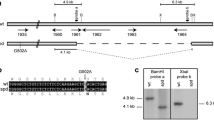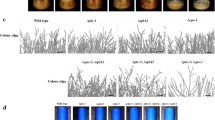Abstract
The Neurospora crassa fmf-1 mutation exerts an unusual ‘perithecium-dominant’ developmental arrest; fmf-1 × fmf-1 + cross becomes arrested in perithecial development regardless of whether the mutant participates in the cross as the male or female parent. We localized fmf-1 to the LG IL genome segment between the centromere-proximal breakpoint of the chromosome segment duplication Dp(IL)39311 and the centromere. By mapping crossovers with respect to RFLP markers in this region we further localized fmf-1 to an approximately 34-kb-genome segment. Partial sequencing of this segment revealed a point mutation in the gene NCU 09387.1, a homologue of the Schizosaccharomyces pombe ste11 + regulator of sexual development. The fmf-1 mutation did not complement a NCU 09387.1 deletion mutation, and transformation with wild-type NCU 09387.1 complemented fmf-1. S. pombe Ste11 protein (Ste11p) is a transcription factor required for sexual differentiation and for the expression of genes required for mating pheromone signalling in matP and matM cells. If FMF-1 also plays a corresponding role in mating pheromone signalling in Neurospora, then protoperithecia in an fmf-1 × fmf-1 + cross would be unable to either send or receive sexual differentiation signals and thus become arrested in development.
Similar content being viewed by others
References
Bhat A., Tamuli R. and Kasbekar D. P. 2004 Genetic transformation of Neurospora tetrasperma, demonstration of repeat-induced point mutation (RIP) in self crosses, and a screen for recessive RIP-defective mutants. Genetics 167, 1155–1165.
Bistis G. N. 1983 Evidence for diffusible, mating type-specific trichogyne attractants in Neurospora crassa. Exp. Mycol. 7, 292–295.
Borkovich K. A., Alex L. A., Yarden O., Freitag M., Turner G. E., Read N. D. et al. 2004 Lessons from the genome sequence of Neurospora crassa: tracing the path from genomic blueprint to multicellular organism. Microbiol. Mol. Biol. Rev. 68, 1–108.
Bruchez J. J. P., Eberle J. and Russo V. E. A. 1993 Regulatory sequences in the transcription of Neurospora crassa genes: CAAT box, TATA box, introns, poly (A) tail formation sequences. Fung. Genet. Newslett. 40, 89–96.
Centola M. and Carbon J. 1994 Cloning and Characterization of centromeric DNA from Neurospora crassa. Mol. Cell Biol. 14, 1510–1519.
Davis R. H. and De Serres F. J. 1970 Genetic and microbiological research techniques for Neurospora crassa. Methods Enzymol. 17, 79–143.
Galagan J. E., Calvo S. E., Borkovich K. A., Selker E. U., Read N. D., Jaffe D. et al. 2003 The genome sequence of the filamentous fungus Neurospora crassa. Nature 422, 859–868.
Galagan J. E. and Selker E. U. 2004 RIP: the evolutionary cost of genome defense. Trends Genet. 20, 417–423.
Johnson T. E. 1979 A Neurospora mutation that arrests perithecial development as either male or female parent. Genetics 92, 1107–1120.
Kim H. and Borkovich K. A. 2004 A pheromone receptor gene, pre-1, is essential for mating type specific directional growth and fusion of trichogynes and female fertility in Neurospora crassa. Mol. Microbiol. 52, 1781–1798.
Kim H. and Borkovich K. A. 2006 Pheromones are essential for male fertility and sufficient to direct chemotropic polarized growth of trichogynes during mating in Neurospora crassa. Eukaryot. Cell 5, 544–554.
Kjærulff S., Andersen N. R., Borup M. T. and Nielsen O. 2007 Cdk phosphorylation of the Ste11 transcription factor constrains differentiation-specific transcription to G1. Genes Dev. 21, 347–359.
Kunitomo H., Higuchi T., Iino Y. and Yamamoto M. 2000 A zinc-finger protein, Rst2p, regulates transcription of the fission yeast ste11+ gene, which encodes a pivotal transcription factor for sexual development. Mol. Biol. Cell 11, 3205–3217.
Mata J. and Bahler J. 2006 Global roles of Ste11p, cell type, and pheromone in the control of gene expression during early sexual differentiation in fission yeast. Proc. Natl. Acad. Sci. USA 103, 15517–15522.
Newmeyer D. 1970 A suppressor of the heterokaryon incompatibility associated with mating type in Neurospora crassa. Can. J. Genet. Cytol. 12, 914–926.
Perkins D. D. 1997 Chromosome rearrangements in Neurospora and other filamentous fungi. Adv. Genet. 36, 239–398.
Perkins D. D., Radford A. and Sachs M. S. 2001 The Neurospora compendium: chromosomal loci. Academic Press, San Diego.
Qin J., Kang W., Leung B. and McLeod M. 2003 Ste11p, a high-mobility-group box DNA-binding protein, undergoes pheromone- and nutrient-regulated nuclear-cytoplasmic shuttling. Mol. Cell. Biol. 23, 3253–3264.
Rosa A. L., Haedo S. D., Temporini E. D., Borioli G. A. and Mautino M. R. 1997 Mapping chromosome landmarks in the centromere I region of Neurospora crassa. Fung. Genet. Biol. 21, 315–322.
Shiu P. K., Raju N. B., Zickler D. and Metzenberg R. L. 2001 Meiotic silencing by unpaired DNA. Cell 107, 905–916.
Staben C., Jensen B., Singer M., Pollock J., Schechtman M., Kinsey J. and Selker E. 1989 Use of a bacterial Hygromycin B resistance gene as a dominant selectable marker in Neurospora crassa transformation. Fung. Genet. Newslett. 36, 79–81.
Sugimoto A., Iino Y., Maeda T., Watanabe Y. and Yamamoto M. 1991 Schizosaccharomyces pombe ste11 + encodes a transcription factor with an HMG motif that is a critical regulator of sexual development. Genes Dev. 5, 1990–1999.
Vyas M., Ravindran C. and Kasbekar D. P. 2006 Chromosome segment duplications in Neurospora crassa and their effects on repeat-induced point mutation (RIP) and meiotic silencing by unpaired DNA. Genetics 172, 1511–1519.
Author information
Authors and Affiliations
Corresponding author
Additional information
We dedicate this paper to our friend Namboori Bhaskara Raju, Stanford University, to recognize his many quiet, yet very significant, contributions to fungal biology. He continues to be such a fine example for the rest of us.
Electronic supplementary material
Rights and permissions
About this article
Cite this article
Iyer, S.V., Ramakrishnan, M. & Kasbekar, D.P. Neurospora crassa fmf-1 encodes the homologue of the Schizosaccharomyces pombe Ste11p regulator of sexual development. J Genet 88, 33–39 (2009). https://doi.org/10.1007/s12041-009-0005-2
Received:
Revised:
Accepted:
Published:
Issue Date:
DOI: https://doi.org/10.1007/s12041-009-0005-2




